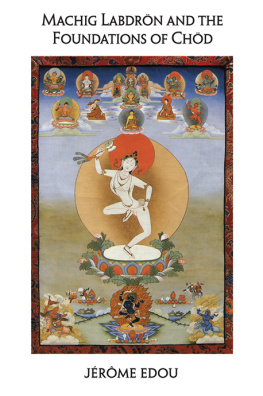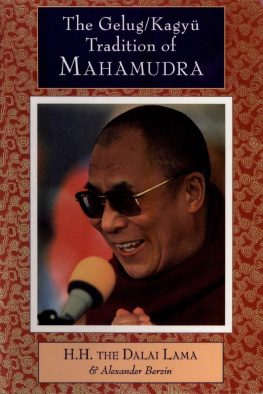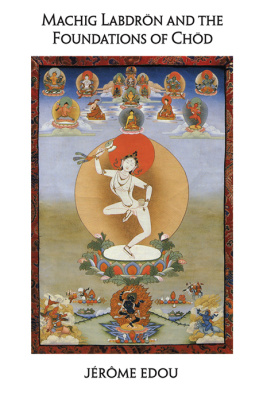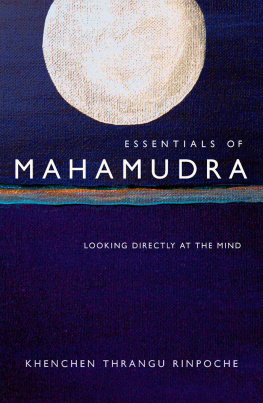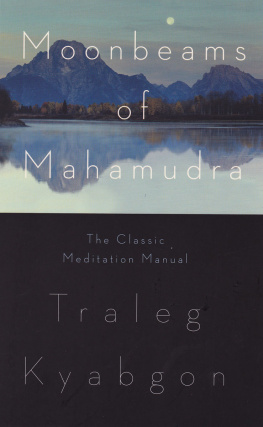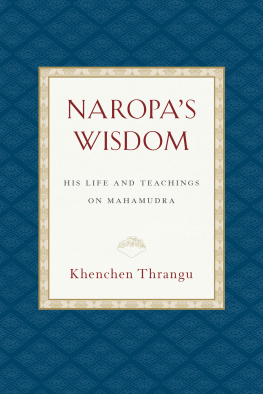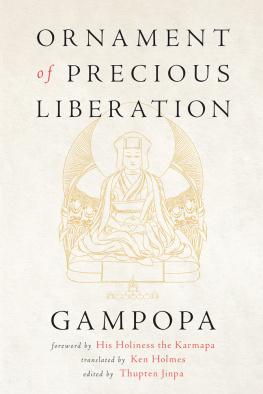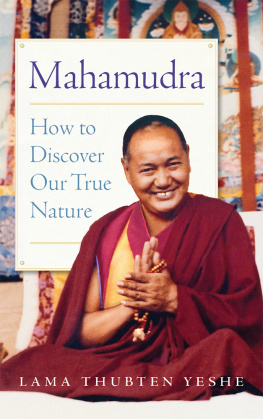Sign up to receive news and special offers from Shambhala Publications.

Or visit us online to sign up at shambhala.com/eshambhala.
MACHIG LABDRN
and the Foundations of Chd
Jrme Edou
Snow Lion
Boulder
Snow Lion
An imprint of Shambhala Publications, Inc.
4720 Walnut Street
Boulder, Colorado 80301
www.shambhala.com
1996 by Jrme Edou
Cover: Thangka of Machig Labdrn
Cover design: Sidney Piburn/Wendy Kenigsberg
All rights reserved. No part of this book may be reproduced in any form or by any means, electronic or mechanical, including photocopying, recording, or by any information storage and retrieval system, without permission in writing from the publisher.
Library of Congress Cataloging-in-Publication Data
Edou, Jrme, 1952
Machig Labdrn and the foundations of Chd / Jrme Edou
p. cm.
Includes bibliographical references and index.
eISBN 9780834841017
ISBN 9781559390392
1. Gcod (Buddhist rite). 2. Labdrn Machig, 10551153. I. Title.
BQ7699.G36E36 1995
294.3923dc20
94-40283
CIP
To the mother of all the Victors of the three times,
The inconceivable and sublime Prajpramit,
I bow down in full prostration.
She, the very essence of space devoid of all origin and cessation,
The selfborn sphere of primordial wisdom.
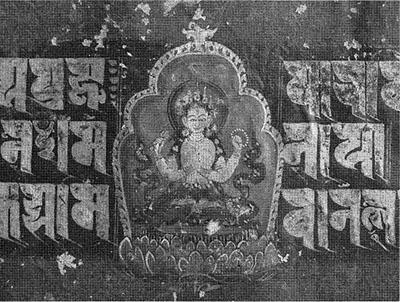
Prajpramit or Yum Chenmo, the primordial mother of wisdom, from a rare Newari manuscript. Photo courtesy of R. A. Kluenter.
Special thanks to:
Human and non-human kins for their inspiration,
Khenpo Tsultrim Gyamtso for the motivation,
Janet Gyatso for her compilation,
Tashi Tsering, Cyrus Stearns, Matthew Kapstein and Matthieu Ricard for their suggestions,
Maruta Kalnins, Michelle Martin and Karry Moran for their corrections,
Dolpopa Tenzin Norbu for the illustrations,
Snow Lion for the publication, and the editor, Susan Kyser, for bringing it to completion,
Nicole, Jonathan and Kim for all the hours stolen from their attention.
Look into the mirror of your mind,
Mahmudr,
The mysterious home of the kin.
Mahsiddha Tilopa
It began at a farmhouse in the lower Alps where I was staying with a Tibetan lama recently arrived from India. That evening I heard resounding from his room the slow rhythm of a haunting melody which he intoned in his rich bass voice, accompanying himself with drum and bell, occasionally blowing the thighbone horn. Throughout the night I was held spellbound by this moving song, so different from any other ritual chant I had ever heard before. I suddenly found myself immersed in the strange and bewildering universe of Chd an ageless world of such antiquity as to have survived only in some forgotten isolated pockets of the Tibetan highlands.
Ever since that evening more than fifteen years ago, I havent been able to let go of Machig Labdrn, the eleventh-century Tibetan lady who was the primary source of inspiration for the Chd tradition. I looked for her in the Himalayan foothills and in the monasteries of Ladakh and Dolpo. I traced her footprint at Tigers Den (Taktsang) in Bhutan and sensed her presence at her former retreat place of Copper Mountain (Zangri), among the nuns of Shuksep, as well as at Dampa Sangys hermitage at the foot of Mt. Everest. I read echoes of her passing and of her lasting influence in texts, on walls and along pilgrimage routes. On the banks of Lake Namtso, for instance, during the coldest month of the Tibetan winter, I found a group of nomads practicing the Chd of Machig in a cave of Tashido, the Rock of Good Fortune.
Several lamas in the authentic transmission lineage of Chd have advised me throughout this lengthy project, enabling me today to present this translation of the most famous biography of Machig Labdrn (1055-1153) together with an outline of her tradition, the Chd of Mahmudr. This translation and most of the commentaries come from two main texts, the first of which is known as An Exposition of Transforming the Aggregates into an Offering of Food, Illuminating the Meaning of Chd (henceforth Transforming the Aggregates).
Finally, while travelling in Dolpo just a few months before printing this book, I found at Lang Gonpa near Phyger a third version of Machigs hagiography called simply A Biography of Machig, an anonymous and unpublished manuscript, quite different from the other two versions, which I have used as a reference.
The need to take up this research before the disappearance of the last witnesses of the living tradition of Tibet has lent a sense of urgency to the enterprise. The corpus of texts by now assembled has become quite overwhelming and the subject in itself is vast, even taking into account the loss of numerous sources of information in the twentieth-century cyclone of cultural devastation unleashed over Tibet. Within the limits of this study certain choices seemed imperative. Some aspects were expanded, others eliminated altogether. At the core remain a number of extracts from the available Tibetan literature, presented in the light of authentic commentaries from the oral tradition.
Having had the opportunity to live and study in close proximity to Tibetan lamas, yogins and erudite scholars, I have been able to address them with my numerous questions. Some replied, others merely smiled. From the Venerable Tenga Rinpoch I received the transmission of the rite. From the Venerable Gendn Rinpoch and Kalu Rinpoch I obtained the initiation of Machig (the latter, during a private interview, showed me a relic of Machigs son which he constantly carried on him in his personal gau). I received the explanations and commentaries on the practice, as well as the meditation transmission, from the Venerable Khenpo Tsultrim Gyamtso, accomplished yogin and incomparable scholar, who encouraged me to undertake the present work, and its completion is definitely thanks to his inspiration. In spite of remaining errors and imperfections for which I am solely responsible, I sincerely hope that
Just like the dawn sun rising in the night sky,
This authentic teaching aimed at cutting through demons
Might cause the light to burst forth in all directions of space.
PHAT!
J.E.
Bauddha, Kathmandu
June 1995
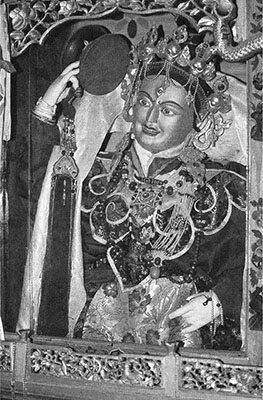
Statue of Machig Labdrn, Shukseb Nunnery near Lhasa. Photo: J. Edou.
All the Dharmas originated in India
And later spread in Tibet.
Only Machigs teaching, born in Tibet,
Was later introduced in India and practiced there.
The Marvelous Life of Machig Labdrn
After the Samy debate of 792-794 sealed the victory of Indian Buddhism in Tibet, the apostasy of Langdarma, last king of the Tibetan dynasty, left institutional Buddhism in shambles, with its monasteries destroyed or abandoned and its monks dispersed or forced to marry. Following the death of Langdarma towards the end of the ninth century, the kingdom broke up into a multitude of principalities that wore themselves out in unceasing confrontations, while the Bnpo priests regained the power that had seemingly slipped from their hands.
About a century later, the conflicts had come to an end and Tibet naturally turned towards India as a source from which to draw cultural and religious elements for its own renewal. The warlords, who had failed to impose any definite victory through military means, now tried to base their temporal power on an association with the reemerging power of religious authorities, while also actively supporting the arts, medicine and the translation of texts.
Next page
